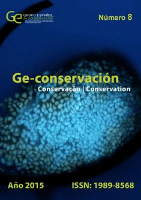
Ge-Conservacion
Scope & Guideline
Advancing the Future of Cultural Heritage Conservation
Introduction
Aims and Scopes
- Interdisciplinary Conservation Practices:
The journal emphasizes interdisciplinary approaches to conservation, integrating techniques from art history, archaeology, chemistry, and environmental science to address the complexities of preserving cultural heritage. - Innovative Conservation Techniques:
Ge-Conservacion focuses on the development and application of innovative technologies and methodologies, such as digital imaging, material analysis, and environmental monitoring, to enhance conservation efforts. - Cultural Heritage Management:
The journal explores the management aspects of cultural heritage, including the implications of conservation on cultural identity, tourism, and sustainable practices, reflecting the broader social context of heritage preservation. - Historical and Technical Studies:
A significant part of the journal's scope includes the historical and technical analysis of artworks and artifacts, providing insights into their composition, provenance, and the impact of various conservation treatments. - Environmental Impact on Heritage:
The journal addresses the effects of environmental factors on cultural heritage, studying vulnerabilities and proposing strategies for mitigation and sustainable conservation.
Trending and Emerging
- Digital Technologies in Conservation:
There is a growing emphasis on the use of digital technologies, such as 3D modeling, virtual reality, and advanced imaging techniques, to document and analyze cultural heritage, enhancing both research and public engagement. - Sustainable Conservation Practices:
Recent papers highlight the importance of sustainability in conservation efforts, focusing on eco-friendly materials and methods that minimize environmental impact while preserving heritage. - Impact of Conflict on Heritage:
The journal has increasingly addressed the vulnerabilities of cultural heritage in conflict zones, particularly in light of the ongoing war in Ukraine, emphasizing the need for protective measures and documentation. - Material Science in Conservation:
There is a notable trend towards incorporating material science into conservation studies, with research focusing on the characterization of materials used in artworks and artifacts to inform conservation strategies. - Community Engagement in Conservation:
Emerging themes include the role of community involvement and participatory models in conservation projects, reflecting a shift towards more inclusive practices that recognize the value of local knowledge and stakeholders.
Declining or Waning
- Traditional Methods of Conservation:
There has been a noticeable decrease in studies focused solely on traditional conservation techniques, as the field increasingly embraces innovative and technology-driven approaches. - General Art Historical Studies:
Papers that focus broadly on art history without a direct connection to conservation or restoration practices are becoming less common, indicating a shift towards more applied research. - Local and Regional Case Studies:
Research centered on specific local or regional conservation issues is waning, possibly overshadowed by more global or comparative studies that address broader themes in heritage conservation. - Conservation of Non-Material Heritage:
There is a decline in publications related to the conservation of intangible cultural heritage, as the journal appears to focus more on tangible artifacts and structures. - Theoretical Frameworks in Conservation:
Contributions that delve deeply into theoretical discussions about conservation philosophy and ethics are less frequent, suggesting a preference for practical, case-based studies.
Similar Journals

BULLETIN MONUMENTAL
Illuminating France's Monumental Treasures.BULLETIN MONUMENTAL, published by the Société Française d'Archéologie Musée Monument Français, stands as a pivotal journal in the field of archaeology and architectural history. With its ISSN of 0007-473X, this journal features a rich compilation of research and insights dedicated to the preservation and study of France's monumental heritage. Although it is not currently open access, its contributions are critical for scholars, professionals, and students interested in the intersection of history, culture, and preservation practices. Covering a continuous period from 2002 to 2016, the journal has played an essential role in documenting advancements in archaeological methodology and conservation efforts, making it an invaluable resource in its field. Researchers seeking to deepen their understanding of architectural monuments in France will find BULLETIN MONUMENTAL a vital source of scholarly articles and field studies.
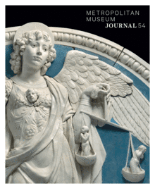
METROPOLITAN MUSEUM JOURNAL
Fostering Scholarly Discourse on Art PreservationMETROPOLITAN MUSEUM JOURNAL, published by the University of Chicago Press, serves as a vital platform for researchers, professionals, and students in the fields of Conservation and Museology. With an ISSN of 0077-8958 and an E-ISSN of 2169-3072, this journal emphasizes the importance of scholarly discourse on art preservation and museum practices. Although it currently holds a Q4 ranking in both Conservation and Museology according to the 2023 category quartiles, the journal continues to contribute to advancements and discussions within these vital fields. Located in Belgium, the journal's mission is to illuminate best practices, innovative techniques, and significant case studies that inform the future of museum work. As an indispensable resource for those dedicated to the arts and humanities, METROPOLITAN MUSEUM JOURNAL fosters a community for exchanging ideas and insights, crucial for the ongoing development and understanding of museum methodologies.

Disegnarecon
Fostering interdisciplinary dialogue for a dynamic future.Disegnarecon is a distinguished open access journal published by UNIV L AQUILA that has been contributing to the fields of architecture, urban studies, and the visual and performing arts since its inception in 2008. With an ISSN of 1828-5961, this journal serves as a pivotal platform for researchers, practitioners, and students to disseminate innovative ideas and findings. Renowned for its rigorous peer-review process, Disegnarecon has achieved notable rankings in 2023, securing a Q2 quartile in Architecture, a Q3 quartile in Urban Studies, and a prestigious Q1 quartile in Visual Arts and Performing Arts, highlighting its academic significance. The journal’s commitment to fostering interdisciplinary dialogue is further emphasized by its impressive Scopus ranks, where it stands at Rank #136 in Visual Arts and Performing Arts and Rank #96 in Architecture. Aimed at advancing knowledge and practice in its respective fields, Disegnarecon is an essential resource for anyone dedicated to exploring the intersections of design, culture, and urban environments, encouraging active participation in contemporary discourse.
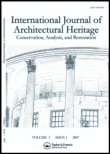
International Journal of Architectural Heritage
Championing the Art of Conservation and Architecture.The International Journal of Architectural Heritage is a premier publication dedicated to the multidisciplinary fields of architecture, conservation, and visual arts. Published by TAYLOR & FRANCIS INC, this journal serves as a vital platform for scholars and practitioners who aim to advance knowledge in the preservation of cultural heritage and architectural innovation. With an impressive impact factor reflecting its critical acclaim, including rankings in the top quartile (Q1) across multiple categories in 2023, the journal is recognized as a key resource in Arts and Humanities, particularly in Visual Arts and Performing Arts and Conservation. Since its inception in 2007, the journal has consistently provided rigorous peer-reviewed research, offering enriching insights and fostering collaborations amongst students, researchers, and professionals committed to the future of architectural heritage. As it continues to influence the field through its diverse and impactful contributions, readers can expect to engage with leading-edge studies that not only illuminate current trends but also inspire innovative practices in safeguarding architectural legacies.
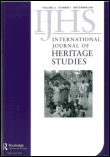
International Journal of Heritage Studies
Fostering critical analysis in heritage conservation.Welcome to the International Journal of Heritage Studies, a prestigious publication dedicated to advancing knowledge in the fields of heritage conservation, cultural studies, and museology. Published by Routledge Journals, Taylor & Francis Ltd in the United Kingdom, this journal boasts an impressive impact ranking, positioned in the Q1 category for multiple disciplines, including Conservation and Cultural Studies, and a remarkable HIndex indicative of its influence within academia. With a history spanning from 1994 and continuing to 2024, the journal serves as an essential platform for researchers, professionals, and students aiming to contribute to the dynamic discourse surrounding heritage preservation and cultural management. Although the journal does not offer open access, it remains a vital resource for those interested in the nuanced intersections of heritage and society, as evidenced by its high ranks in various academic categories. The International Journal of Heritage Studies is committed to fostering innovative research and critical analysis in its field, inviting submissions that explore diverse methodologies and theoretical perspectives.

Landscape Architecture and Art
Innovating Landscapes Through Artistic VisionLandscape Architecture and Art is a distinguished journal published by the Latvia University of Life Sciences and Technologies, specializing in the intersection of landscape architecture, environmental design, and the visual arts. Established in 2016, this journal has rapidly garnered recognition in various academic categories, achieving Q3 ranking in Agricultural and Biological Sciences (miscellaneous), Q4 in Geography, Planning and Development, and notably Q1 in Visual Arts and Performing Arts as of 2023. With its ISSN 2255-8632 and E-ISSN 2255-8640, the journal provides an essential platform for researchers, professionals, and students to explore innovative approaches and sustainable practices in landscape design and conservation. Although currently not open access, the journal's commitment to high-quality research is evident through its impressive Scopus rankings, particularly in the Arts and Humanities with a commendable 88th percentile for Visual Arts and Performing Arts. Located in Jelgava, Latvia, this journal serves as a vital resource for advancing knowledge and fostering collaboration in the fields of landscape architecture and environmental stewardship.

Quiroga-Revista de Patrimonio Iberoamericano
Connecting Cultures: Preserving the Past, Inspiring the FutureQuiroga-Revista de Patrimonio Iberoamericano, published by UNIV GRANADA, is a distinguished open-access journal dedicated to the fields of conservation, museology, and the visual and performing arts. Since its inception in 2012, the journal has provided a platform for scholars and practitioners to disseminate innovative research and critical discussions pertinent to Ibero-American heritage. With a growing impact, evidenced by its category quartiles ranking—Q3 in Conservation and Q2 in both Museology and Visual Arts and Performing Arts—as well as its Scopus rankings, Quiroga serves as an essential resource for researchers, professionals, and students who engage with the complexities of cultural preservation and artistic expression. The journal’s commitment to open access ensures the widespread availability of knowledge, fostering academic dialogue and collaboration within the global community. For inquiries, the journal can be reached at their offices located in Granada, Spain.

Rijksmuseum Bulletin
Showcasing Innovative Research in Arts and CultureThe Rijksmuseum Bulletin, published by the Rijksmuseum Amsterdam, stands as a premier open-access journal in the realm of Visual Arts and Performing Arts, having transitioned to open access in 2012. With its ISSN 1877-8127, the journal is dedicated to exploring the rich tapestry of art history, exhibitions, and cultural discourse, supporting both scholarly research and the general appreciation of the arts. As a significant contributor within the Netherlands and beyond, the Bulletin garners a solid reputation, reflected in its current ranking in the Q3 category of Visual Arts and Performing Arts, with a Scopus rank of #510 out of 667. This engaging platform not only disseminates high-quality research but also fosters collaboration among researchers, professionals, and students, providing insights that highlight the importance of cultural heritage. With converged years spanning from 2011 to 2024, the Rijksmuseum Bulletin is poised to remain a vital source of knowledge within the arts community.

International Journal of Conservation Science
Shaping the Future of Conservation through CollaborationThe International Journal of Conservation Science, published by the Romanian Inventors Forum, is a premier, Open Access journal dedicated to advancing the field of conservation science since its foundation in 2010. With a strong emphasis on interdisciplinary research, the journal welcomes contributions that explore innovative methodologies and sustainable practices in conservation. Based in Romania, the journal boasts an impact factor that positions it as a leading voice in its field, reflected by its Q1 ranking in Conservation and notable placements within its categories in Scopus. With coverage spanning diverse areas from natural resource management to environmental education, the journal serves as a crucial platform for researchers, policymakers, and practitioners aiming to drive impactful conservation strategies globally. The International Journal of Conservation Science not only enhances the visibility of significant research but also promotes open dialogue and collaboration among professionals committed to preserving our natural heritage.
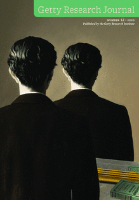
Getty Research Journal
Illuminating Cultural Heritage Through ResearchGetty Research Journal, published by University of Chicago Press, is an influential periodical in the fields of Conservation, History, Museology, and Visual Arts and Performing Arts. Established in the United States, this journal aims to foster scholarly discourse and advance research in the visual arts and cultural heritage, making it a vital resource for researchers, professionals, and students alike. While it holds a Q4 ranking across multiple disciplines in the 2023 category quartiles, indicating opportunities for growth and engagement, its unique focus on the interplay between art, history, and conservation provides a distinct platform for innovative ideas. The journal encompasses a diverse range of topics, encouraging interdisciplinary research that underscores the importance of the arts in society. As it converges years from 2015 to 2024, the Getty Research Journal serves not just as a publication, but as a dynamic forum for critical thought and exploration in the expansive realm of art and culture.